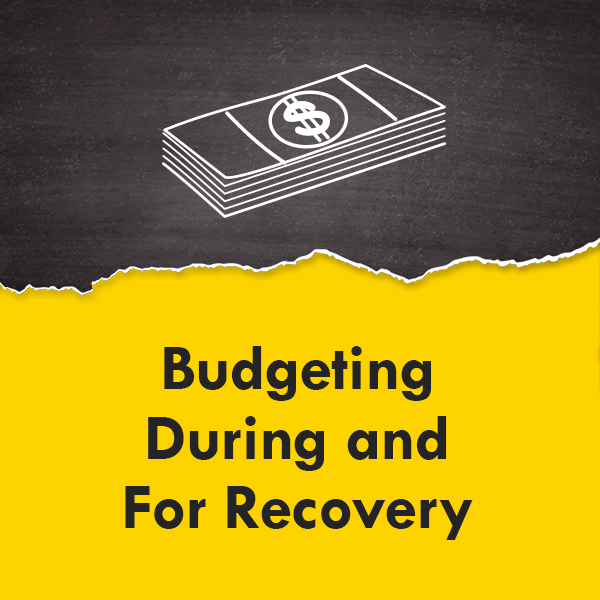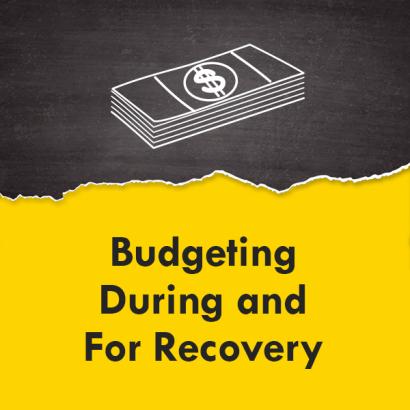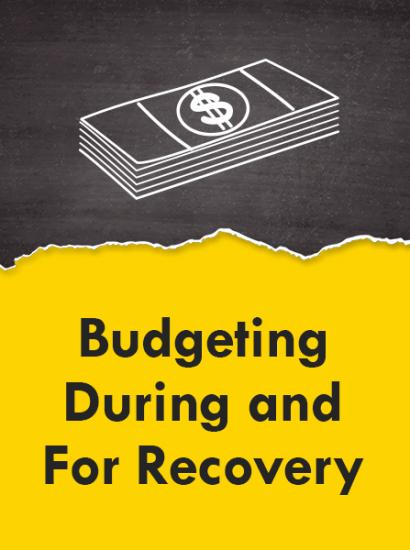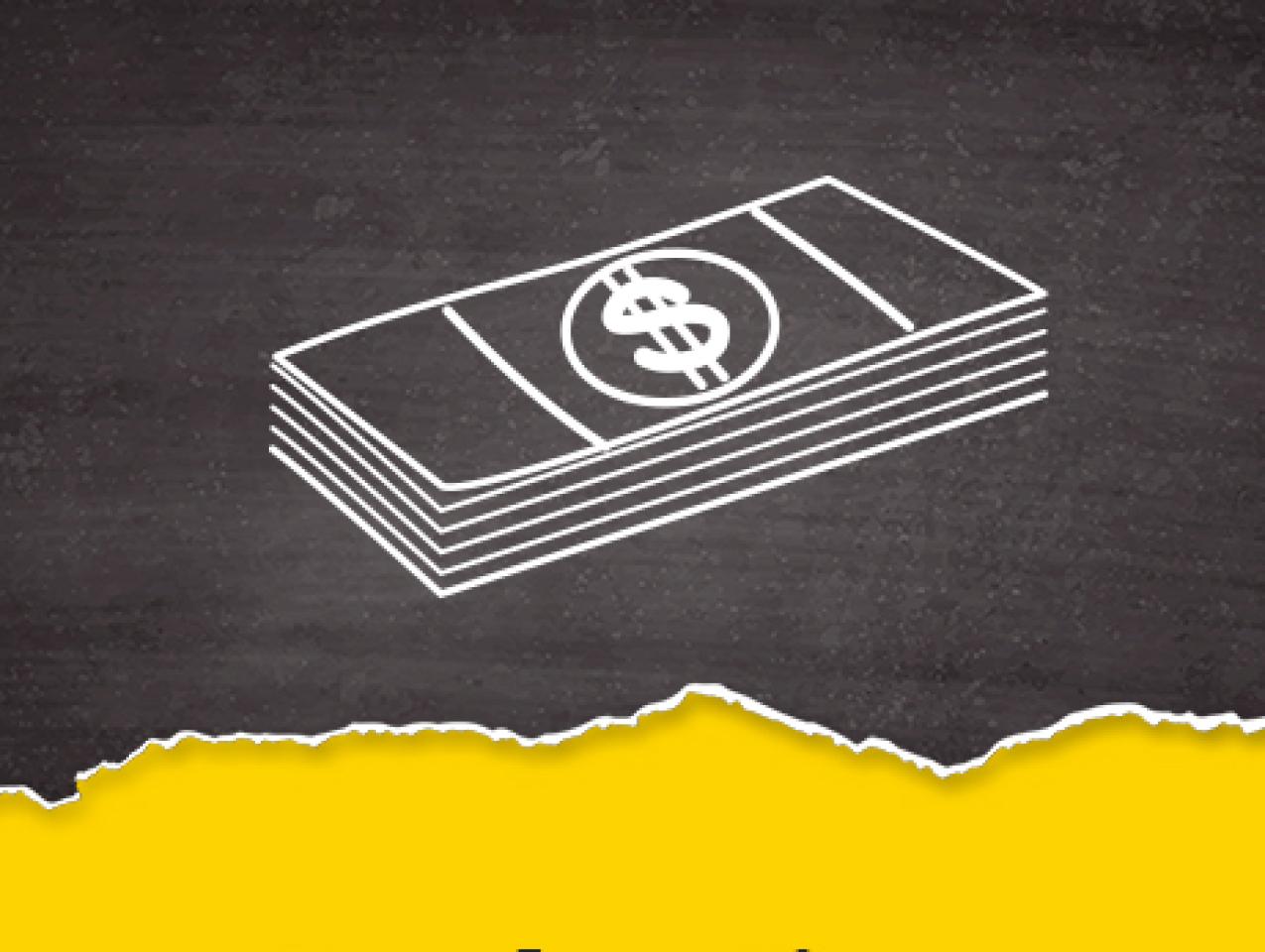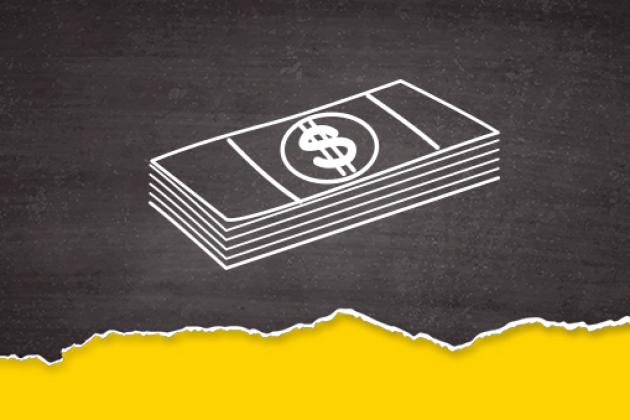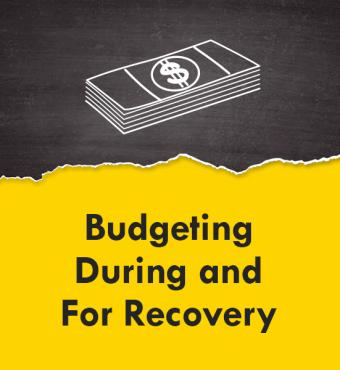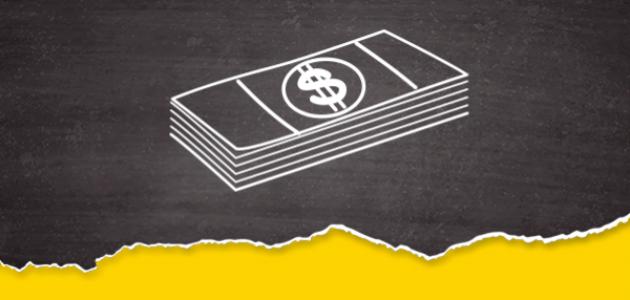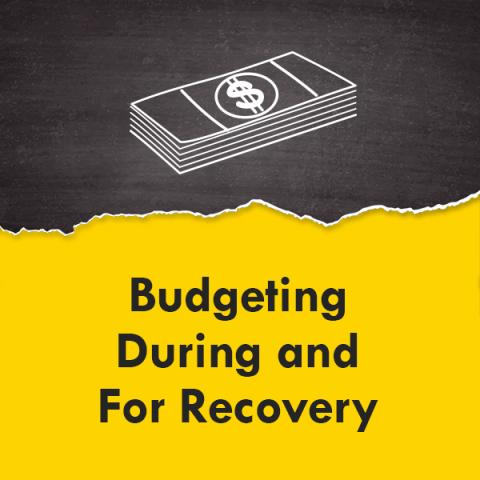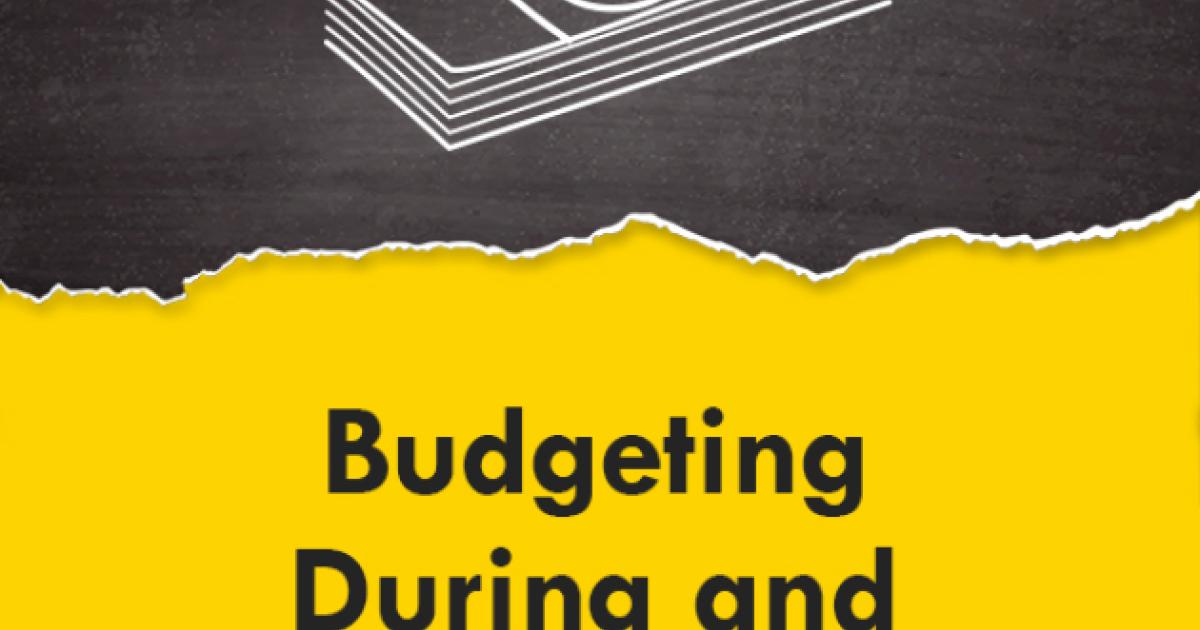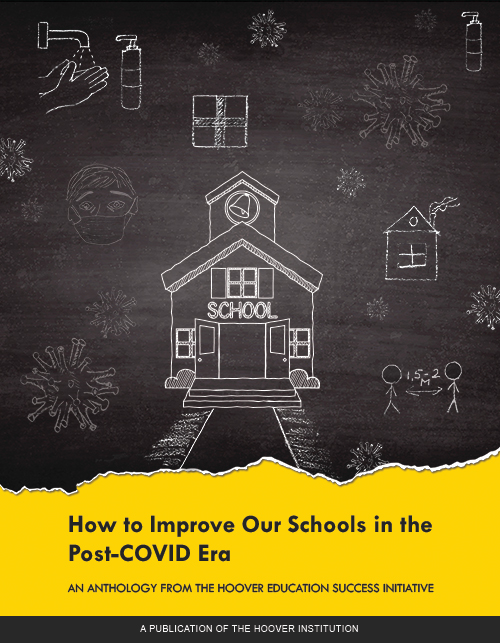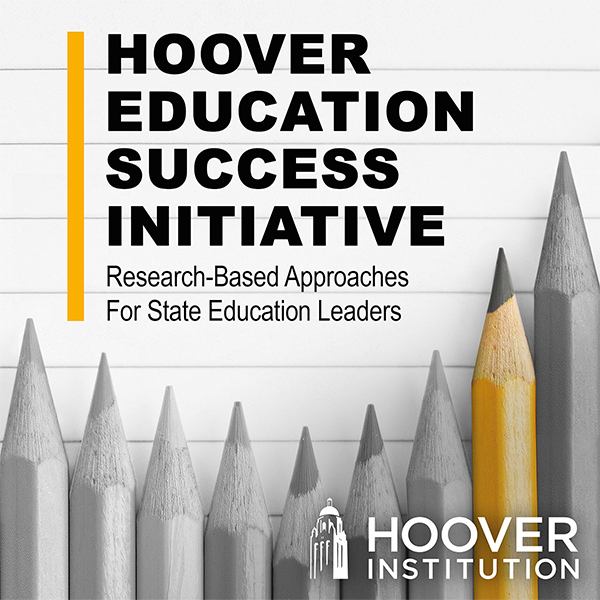- Education
- Reforming K-12 Education
Summary of Major Recommendations ✏1
- Short-run spending must be separated from long-run, steady-state expenditure.
- Funding needs to be focused on results, not just seat time.
- Outdated and restrictive regulations must be addressed.
- Funding should be neutral with respect to supplier (i.e., don’t thwart charters and choice).
School Finance with COVID-19
Considerable uncertainty surrounds the overall state of school finance coming out of the pandemic. As unemployment peaked soon after the economic lockdowns that involved most states after March 2020, states became very concerned about the expected future tax revenues, and they began planning a retrenchment in all spending, including that for schools. In response to the overall economic situation and recognizing the potential problems of schools, the federal government increased its spending—directing specific portions of funds to schools. As the pandemic subsides and the economy returns to its prior level, uncertainty about school finance remains.
On the revenue side, while it seems unlikely that the federal government will continue funding at the “emergency rate,” it is not clear whether it will continue at levels above its historic rate. It is also unclear what the states will do, particularly with a reduction in federal spending.
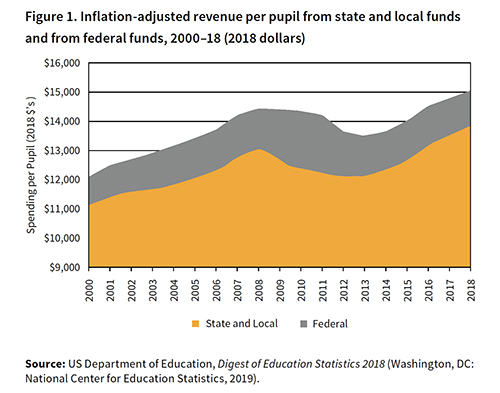
The 2008 recession, while different in some ways from the pandemic experience, provides some indication of possible future developments. Figure 1 shows the pattern of spending during the twenty-first century (adjusted for inflation). As it illustrates, when the recession hit, the federal government provided short-term stimulus funding that was sufficient to maintain funding at roughly the 2007 level. When the federal government reverted to its prior spending levels, educational spending per pupil dipped for a few years until states increased their spending, putting real spending again on a rising path after a couple of added years. The growth in spending returned essentially to the same as it was pre-2008, bringing overall spending above the prerecession level in 2016, eight years after the start of the recession.
The COVID-19 experience is perhaps different, because the 2008 recession took an extended period of time to be worked out of the system. The nature of the COVID-19 economic crunch is entirely different and is unlikely to have as long a tail of impact as the 2008 recession. Nonetheless, the pattern of federal response seems quite likely to be repeated—implying that states and districts will need to rely on their own funding choices fairly soon.
The revenue side is not the only source of financial uncertainty facing schools. There are obvious issues of lingering safety concerns that affect plant and operational matters, from classroom configuration and the range of personal protective equipment (PPE) needed to the integration of internet and digital equipment. These issues are an obvious financial drain compared to the pre-COVID-19 period. Nonetheless, they may not be the largest sources of uncertainty.
First, many school systems suffered significant—and often unexplained—losses of students during the 2020–21 school year. In many cases, the students simply disappeared from sight. Some can be accounted for by movement to charter schools that offered a higher level of in-person classroom instruction; some to increased home schooling; and some simply cannot be located.1 Will these students return? Second, it seems unlikely that we will fully return to the school structure that we knew in 2019. Some students and teachers will not want to return to in-person instruction, leading to continuing remote and hybrid instruction. This continuation will have obvious learning implications, but there are also more direct implications for our current financing of schools.
The cornerstone of school finance systems across the states is payment for student time in class. The formulas that distribute state money to schools invariably estimate students in class by roster counts once or twice during the year or by average daily attendance. But there is currently no consensus even on what attendance is with remote instruction, let alone on what constitutes a “learning day.” Moreover, what should be done about the students who cannot be located?
Other portions of state finance are allocated for special purposes. This categorical aid often has reporting requirements that call for accounting at a detailed programmatic level that can be difficult to document with dispersed learning—and, indeed, the special programs might not make any sense outside of the traditional structure of schools.
To the extent that any funding for schools or for personnel is attached to the accountability system, there is another layer of uncertainty. Accountability systems reflecting student performance measures are obviously compromised by the lack of student testing. The Every Student Succeeds Act (ESSA) requirement of including non-test measures in school accountability has led many states to focus on chronic absenteeism, something that has become exceedingly difficult to measure, along with general rates of attendance.
Much of the adjustment of schools has been focused on returning them to the 2019 structure of schools as soon as possible (with the appropriate safety modifications). ✏2 But all of the information currently available suggests that the 2021–22 school year and maybe beyond (permanently?) will be different from 2019.
Short-Run Actions Should Avoid Adverse Long-Run Implications
The relief aid from the federal government has generally maintained the historical funding levels to schools, but this extra aid is likely to stop after a fairly short period of time as the entire economy returns to life. Perhaps the most important admonition is that schools should not make long-run commitments based on short-run funding. The experiences of the 2008 recession make this clear, because it is doubtful that the federal government will make the school funds in the current economic relief bills permanent.
There are obvious short-run uses of relief funding—expanded internet and technological devices, PPE materials, adjustments to plant—that are important and viable uses of enhanced temporary spending. Moreover, because of the increased variation in student preparation coming out of the closures and the fully remote instruction, there is an obvious need to move toward more individualized instruction. In the short run, there are added costs from new technologies for this and for training teachers in their use—and these activities should receive funding priority.
The concern is that some uses in the short run have important long-term impacts on budgets and flexibility for educational management. ✏3
The temptation to do this is largest in terms of personnel. If one were to assume that all of the students in the schools before the closures of 2020 would return to the traditional public schools, and if one considered the possibility that there were greater rates of teacher retirements because of continuing safety concerns, districts may in fact face shortages of teachers. Such shortages were projected before the COVID-19 period. For example, Sutcher, Darling-Hammond, and Carver-Thomas (2016) projected a shortage of over one hundred thousand teachers in 2018. Such projected shortages are then seen to grow with the COVID-19 experience (e.g., García and Weiss 2020; Carver-Thomas, Leung, and Burns 2021).
Historically, such shortages —and the difficulties in replacing teachers—are much larger in some fields than in others. For example, chronic shortages have been identified in math and science, in special education, and in foreign languages. But such shortages have been recognized for a long time (e.g., Kershaw and McKean 1962).
The full impact of the COVID-19 experience on the teacher labor force is unknown. Whether concerns—due to safety, changes in teaching modes, or whatever—lead to increased retirements and teacher turnover is unclear. A recent survey reported, “Almost half of the public school teachers who voluntarily stopped teaching in public schools after March 2020 and before their scheduled retirement left because of the COVID-19 pandemic” (Diliberti, Schwartz, and Grant 2021). But it also reported a like proportion of teachers leaving for “stress reasons” before the COVID-19 period, and it found no differences in the characteristics of leavers (age, gender, race, tenure, degree level) before or after the COVID-19 period. This suggests that the COVID-19 movements of teachers may not be very different from those in prior periods.
A common proposal is to deal with shortages through substantial across-the-board increases in base pay.2 As described in Hanushek (2020), this policy would have minimal to no effects on the shortages by teaching field or by teacher quality. More importantly, in terms of finance, such a policy would have long-term cost implications that could become very burdensome as the federal government reduces its relief expenditures.
A second instance of long-term policies that would have lasting financial impacts is the idea of ensuring that there are no layoffs of teachers—a policy incorporated into the school spending of the latest federal relief bill. As traditional school systems lose students to a variety of places, maintaining the prior teacher force implies significant reductions in pupil-teacher ratios. Such reductions are again likely to have financial effects that long outlive the temporary COVID-19 funding of schools.
The more attractive alternative is to use the short-run moneys to further long-run objectives related directly to student learning. The change in the structure of schools with substantial hybrid and remote instruction calls for using relief funding to provide incentives for more specialized teaching and instruction. For example, the best teachers at remote science instruction might receive extra compensation to take on larger groups of students in their science blocks. Although the exact structure of in-person instruction in the longer run is currently unclear, the same principle would apply: providing the best in-person teachers with incentives to take on larger groups of students, perhaps with more class meeting hours.
Funding Seat Time is an Increasingly Bad Option
The funding of schools based substantially on student seat time was increasingly problematic even prior to COVID-19.3 As noted, COVID-19 has seriously complicated the situation. The once simple matter of defining attendance has become a complex policy decision and possibly a larger expenditure item itself.
This is a good time to place less emphasis on whether a student is present and more emphasis on achieving given learning outcomes. Such a move would be consistent with emphasizing more individualized instruction where accomplishment of learning goals is the central element. It is obviously difficult and problematic to move entirely away from funding on average daily membership or average daily attendance, but it is more feasible to direct less funding based on these factors and more funding based on learning outcomes. ✏4 The recovery and restructuring period coming out of COVID-19 may be a hectic one, but it is important to begin the restructuring of the finance system along with the changes in school operations.
The objective is to use the finance system to provide incentives for more efficient operations, i.e., operations that get the most learning for the funding. ✏5 Most current finance formulas do not reward learning by students, and changing this would lead to long-run improvements in schools.4[4]
Pre-COVID-19 Regulations and Restrictions Need Attention
✏6 Varying state regulations affect both school operations and the funding of schools in ways that do not make sense in a system with portions of hybrid and remote learning. For example, restrictions or incentives for some level of class sizes do not interact well with expanded operations outside of the classroom or with varying split-attendance schedules. Funding teachers based on fixed pupil-teacher ratios likewise does not work well when schools have alternative structures.
Most of the attention to regulations is of course not from the direct finance implications but from the restrictions on operations that prohibit effective school operations. Indeed, the freedom from many regulations almost certainly contributed to the anecdotal evidence that charter schools fared better in reacting both to initial closures and to the immediate demands in school reopening. The COVID-19 related changes to schools highlight the necessity of identifying and removing outdated and ineffective regulations on school operations.
COVID-19 Restart Calls for Supporting More Options
The early reactions of families to the closures and to the erratic reopening of schools involved a wide variety of movements toward alternatives to the traditional public schools. The lost students are searching for learning opportunities, ones that they thought better than those available in their traditional public schools.
The funding of schools, with its uncertainties to the various suppliers, should not operate to stop these choices. The funding should flow with the students as they make the best of the available local choices.5 It should not be designed to reverse the choices of families.
It may seem natural to address the financial uncertainties by “holding districts harmless” for any changes in student populations caused by the pandemic, but such policies should not remain in place for the long run and should not constrain expanding schools. The “hold harmless” principle can reward districts that do not mount programs sufficiently attractive to retain students and that are slow to adjust to different populations. If budgets are frozen for expanding programs, those that pivoted to the demands of the pandemic and offered more attractive programs are punished. This surely is not the kind of incentive structure that would be desired in a time when student learning losses must be addressed.
References
Bassok, Daphna, and Anna Shapiro. 2021. “Understanding COVID-19-Era Enrollment Drops among Early-Grade Public School Students.” Brookings Institution, February 22.
Carver-Thomas, Desiree, Melanie Leung, and Dion Burns. 2021. “California Teachers and COVID-19: How the Pandemic Is Impacting the Teacher Workforce.” Learning Policy Institute, March 4.
Diliberti, Melissa Kay, Heather L. Schwartz, and David Grant. 2021. “Stress Topped the Reasons Why Public School Teachers Quit, Even before COVID-19.” RAND Corporation Research Report RR-A1121-2.
Finn, Jr., Chester E. 2020. “School Accountability—Past, Present, and Future.” Hoover Education Success Initiative, Hoover Institution, November 19.
García, Emma, and Elaine Weiss. 2020. “A Policy Agenda to Address the Teacher Shortage in US Public Schools.” Economic Policy Institute, October 15.
Hanushek, Eric A. 2020. “The Unavoidable: Tomorrow's Teacher Compensation.” Hoover Education Success Initiative, Hoover Institution, January 30.
Hanushek, Eric A., and Alfred A. Lindseth. 2009. Schoolhouses, Courthouses, and Statehouses: Solving the Funding-Achievement Puzzle in America’s Public Schools. Princeton, NJ: Princeton University Press.
Kershaw, Joseph A., and Roland N. McKean. 1962. Teacher Shortages and Salary Schedules. New York: McGraw-Hill.
Peterson, Paul E. 2020. “Toward Equitable School Choice.” Hoover Education Success Initiative, Hoover Institution, December 1.
Raymond, Margaret E. 2020. “The Diploma Dilemma.” Hoover Education Success Initiative, Hoover Institution, February 11.
Sutcher, Leib, Linda Darling-Hammond, and Desiree Carver-Thomas. 2016. “A Coming Crisis in Teaching? Teacher Supply, Demand, and Shortages in the US.” Palo Alto, CA: Learning Policy Institute, September 15.







